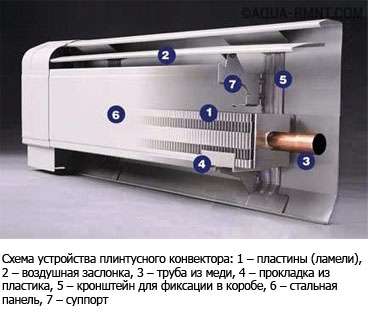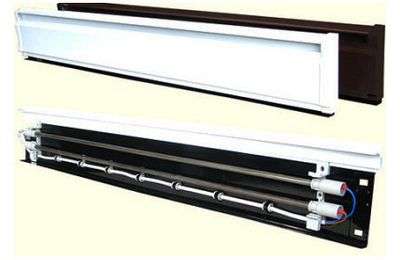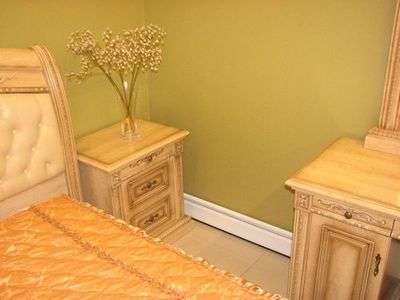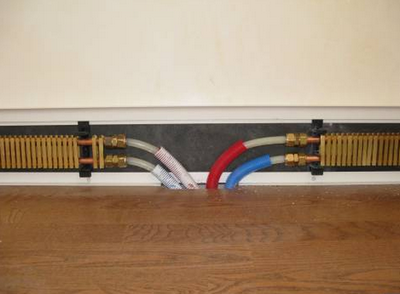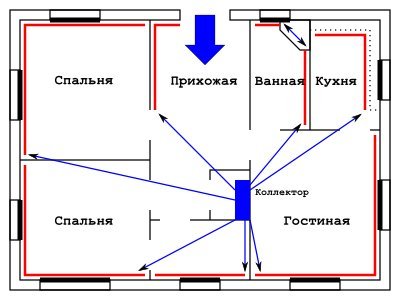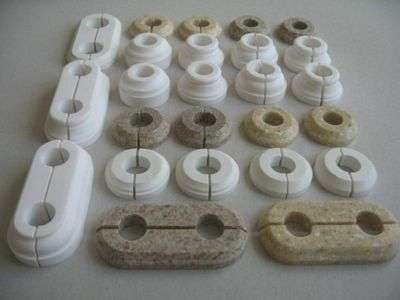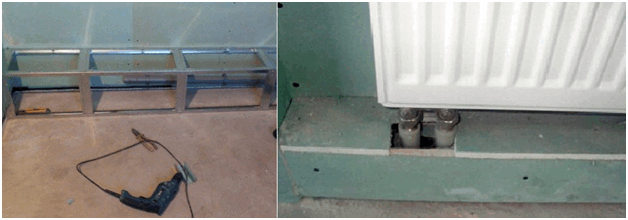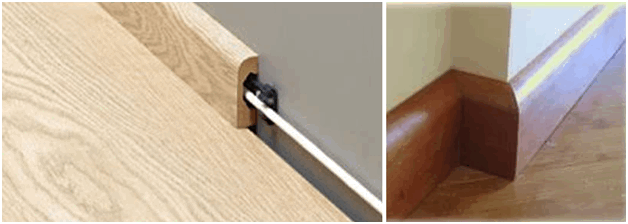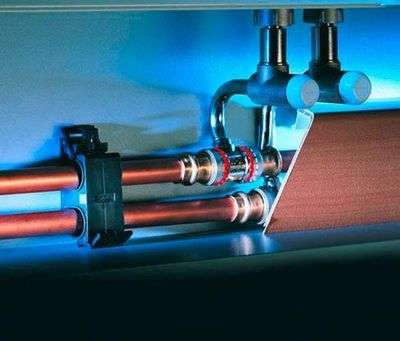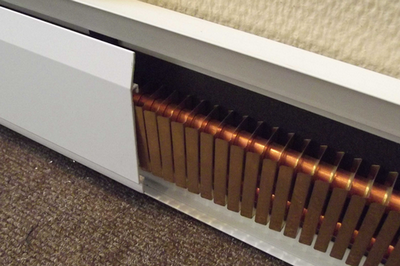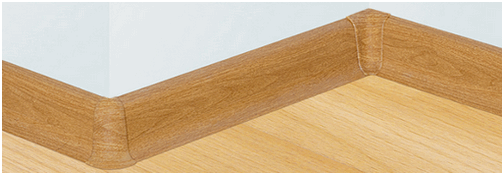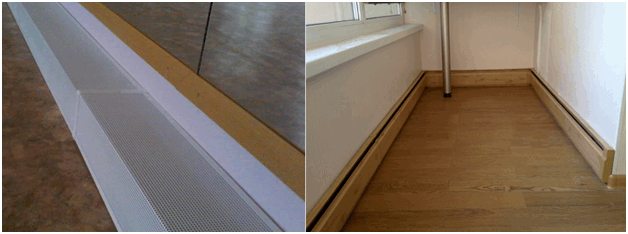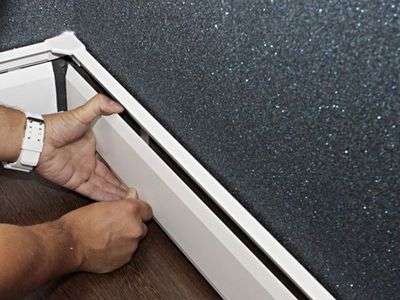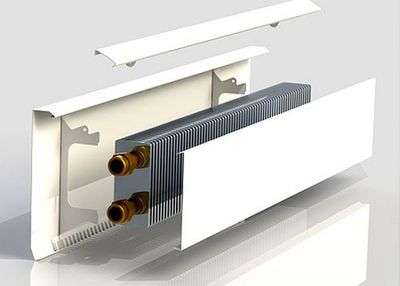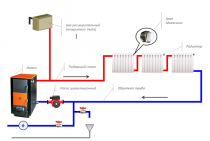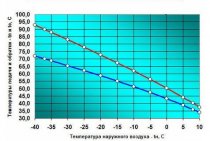Overview of baseboard heating systems
1. Liquid baseboard heating.
The water heating system includes the following elements:
- Radiator block: a heat exchanger made of two copper tubes, on top of which brass or aluminum lamellas are fixed, providing the convection process, and a protective and decorative aluminum box.
- Distribution manifold, consisting of two steel tubes for the input-output of the thermal fluid. It is additionally equipped with air vents, cut-off valves and drain valves.
- Pipes made of polyethylene, dressed in corrugation, through which liquid is delivered and discharged. Mounted along the wall or in the floor. The maximum working pressure should be about 3 atmospheres.
Skirting water heating is sensitive to water hammer and an increase in current pressure as a result of pressure testing, therefore, metal-plastic or copper communications are used instead of polyethylene hoses to connect to a centralized system. Fastening is carried out by soldering. At the same time, experts recommend using an intermediate heat exchanger, which takes on all the "surplus". Thus, the baseboard-type heater is protected from excessive loads, and its service life will correspond to the declared 10-year warranty.
In private houses, a circulation pump, thermostats, sensors are connected at the inlet of the coolant to the collector receiver. To buy a liquid warm baseboard, you will have to spend from 4,000 rubles per meter. m. Manufacturers, as a rule, recommend mounting a circuit no longer than 15 m. Otherwise, the efficiency of the system is significantly reduced. The standard surface temperature of the plinth should be about +50 ° C, with each additional meter the indicator worsens by 2-5 degrees under the same conditions.
According to reviews, liquid-type skirting heaters, although expensive, are effective:
“I installed a baseboard heating system in a children's area of 20 sq. m. The declared power was 200 W per linear meter. In the initial warm-up mode from -10 to +20, the complex proved to be excellent - literally after 20 minutes the room became warm and comfortable. In the future, I will use it at half capacity to maintain the results achieved.”
Veshin Oleg, Tambov.
“The dacha near the lake is damp and dank cold. I chose skirting heating with a copper core for heating. Of course, it turned out to be a little expensive, but the advantages are immediately noticeable: the most even temperature throughout the volume of the room, there is no overheated air as with radiator heating.
Alexander Shilov, St. Petersburg.
2. Plinth electric heating.
Electric plinth refers to air heating systems. The device of the unit is similar to liquid. A heating element is mounted in the lower copper tube, a power cable in a heat-resistant braid is built into the upper one. The maximum power level is 280 W per 1 linear meter. The price of baseboard heating starts from 2,000 rubles / rm. m. Overall dimensions of the unit: height - 16, width - 4 cm, length - 1-2 m. Complete with outer, inner and end caps made of PVC.
Many manufacturers produce both types of baseboard heating, while adapting them to any type of heat generators. Thus, the THERMODUL heating system works in conjunction with gas and oil boilers, solar panels. The design provides for the possibility of adjusting the temperature using thermostats.
Versions with an infrared system are also available. For example, the Russian plinth heater Megador has a power of up to 200 W, the heating area for 1 running meter is 8 m2.Spheres of application are not limited: country houses, apartments, office and industrial premises, garages, greenhouses and others. Warranty period is at least 10 years. Prices for thermal plinths depend on models, additional functions and, of course, the manufacturer.
The cost of baseboard heating in Moscow and the Moscow region.
Advantages and disadvantages of baseboard heating
The advantages include:
- fast, and most importantly, uniform heating of the room, since in fact, the wall of the room is used as a heating surface for air;
- cost-effectiveness - thanks to the speed of heating, the cost of space heating is reduced. In turn, the thermal curtain, which forms a stream of heated air near the walls, prevents heat loss through the wall partitions;
- with the best thermal insulation, the possibility of dampness of the walls is quite high. Heating them significantly reduces the risk of condensation accumulation, mold formation, and, therefore, the destruction of materials;
- low inertia - due to the small size, the devices “turn on” to work faster. The same feature allows you to easily adjust the temperature in a very short time;
- thermoregulation is possible individually for each room;
- fairly simple installation, do-it-yourself;
- decorativeness - the heating plinth is not much wider than the usual floor. The entire heating system is hidden from view and does not interfere with the placement of furnishings at all. The only rule that is recommended to be observed is not to place large pieces of furniture over the heating element, as this reduces its effectiveness.
Flaws:
- the method is designed for a limited area - the length of the circuit should not exceed 15 m;
- installation of the system is the last simplest stage of work. Preliminary calculations and preparation require much more time and accurate calculations;
- the system is effective only if the house is very well insulated.
Baseboard type heating system principle of operation
The warm plinth functions due to the Coanda effect, i.e. due to the reduced pressure formed in the zone of its surfaces. Only one side has free access to air. Air flow spreads over a large area.
Such a heating baseboard requires the installation of radiators on the outside of the wall. The box of aluminum slats has a pair of horizontal holes. When a cold air stream enters, it heats up and rises up. Thus, the entire wall surface is heated as evenly as possible.
Due to the fact that such a heating baseboard works without the participation of convection, strong heating of the coolant is not required. Such radiators have a tube construction made of heat-conducting materials, such as copper or aluminum.
Scheme of installing a radiator in a 3-room house.
decorative rosette
Decorative finishing of heating pipes passing through the floor becomes an acute problem during the laying of parquet. There are two methods for finishing heating pipes.
Decorative overlays for heating pipes
The first method assumes the following: The pipes are quite tightly, without leaving gaps, coil to coil, wrapped with asbestos-containing cardboard. This is done at the height of the future plinth. After that, the place around the pipe is laid with a heat-resistant material with good elasticity.
To cover the cracks, a simple cement mortar is used.
The second method is even simpler. The gap between the parquet and the pipe is filled with an elastic sealant with good heat resistance. The place where the floor and the pipe join is masked with a decorative rosette. Thanks to a wide range of sockets, they can be selected for pipes of any diameter.Sockets for heating pipes consist of two parts, and their connection takes place thanks to a spike. At the junction of the two parts of the socket, they are smeared with glue. After the glue dries, the sockets are connected in a way around the pipe, and then pressed to the floor as tightly as possible. Remove any remaining adhesive with a soft cloth.
Types of plinth covers for heating pipelines
The main feature of the classification of skirting boards for heating pipes is the material of manufacture, which can be divided into 3 main groups:
Each group includes many variants that differ in dimensions, profile, color, surface texture, etc.
In addition, a group of self-made boxes can be added to the above points, which are made on the basis of a cd-profile frame mounted to the wall, followed by plasterboard sheathing and plastic, ceramic tile or mosaic finishing.
- covers without brackets for pipes (screens) - they are attached to the wall over the mounted and fixed pipeline;
- sheath complete with holders for the pipeline - mounted on the installed brackets-holders with pipes.
The choice of decorative plinth should be made with reference to specific operating conditions, including many factors (place of installation, diameter and number of pipes in the lash, the presence of thermal insulation, etc.) and the interior of the room.
Consider options for how to hide heating pipes, and several types of decorative plinth used for finishing pipes of heating systems.
Plinth metal screens
The products are covers of oval or rectangular section made of aluminum or stainless steel, which are butt-to-wall fastened to the wall with self-tapping screws over the mounted pipeline. The surface of such a plinth is perforated, which reduces the weight of the product, makes the heating of the room more uniform and allows for visual control of the tightness of the pipeline. The shell is durable, in case of mechanical damage it is restored by straightening, it is easy to assemble and allows painting.
Such a plinth can be cut into fragments of any length, including those convenient for the location of stop valves above the nodes in case they need to be replaced or repaired.
Casings are installed at any height of pipe laying, it is also possible to place them directly along the junction of the floor with the walls.
Plastic skirting boards
Plastic skirting boards for heating pipes - a budget option for solving the issue. The characteristics of the plastic used for these purposes are generally low. Scratches from mechanical damage remain on the products, some varieties after a year of operation have deviations from the original geometry. But a wide range of material prices allows you to change skirting boards every year or two without any special expenses, at the same time bringing new touches to the interior of the room - there are many options for the artistic execution of these accessories (under precious woods, under natural stone, etc.).
Wooden skirting boards
Wood products are not made in the form of universal models, since the cost of natural wood suitable for a heat-resistant shell is high. Therefore, such a finish is ordered in carpentry or furniture workshops according to individual sizes and sketches.
Skirting boxes made of wood, with proper processing and proper care, are beautiful and durable. The color of wood before coating with a protective layer of varnish can be changed by applying a stain - a tinting composition produced in various colors and saturation.
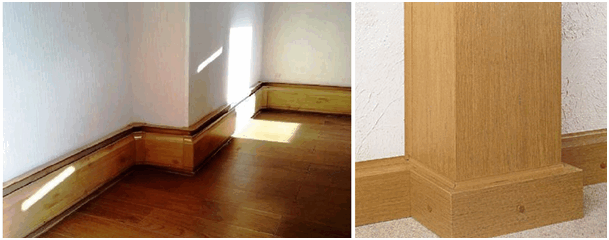
What is baseboard heating?
There are a fairly large number of interesting and fairly economical systems on the market that an ordinary city dweller is not able to use. This is most often due to the inability to provide sufficient thermal insulation of the apartment. Another thing is to own a house, where you can achieve really high performance. Which, in turn, allows the use of non-traditional heating options.
Skirting heating refers to such systems. It got its name due to the installation method: the radiators used for heating are very small in size - 3 * 14 cm, and are installed along the wall of the room. In appearance, they practically do not differ from the usual floor plinth.
The principle of operation is as follows: cold air at floor level is taken into the radiator through the lower hole, heated on the surface of the heat exchanger and supplied to the room through the upper hole. The peculiarity is that the heated air does not move immediately throughout the entire volume of the room, but spreads along the wall, primarily heating its surface. Accordingly, the heating of the room is carried out not so much by the flow of warm air as by the surface of the heated wall. Such a system, judging by the feedback from consumers, mostly European, has many advantages. The photo shows an example of such heating in a private house.
How the system works
The plinth heating system is organized in such a way that the heating elements are installed along the perimeter of the outer walls of the building near the floor, close to their surface.
The heating element box, formed by aluminum strips, has in its design two horizontal slots running along its entire length from opposite sides - one near the floor, and the other on top.
Cold air penetrates through the lower slot into the baseboard, where it heats up and rises, but unlike other heating devices operating on the principles of convection, then the heated air, obeying the Coanda effect described above, spreads only along the surface of the wall, giving it heat.
As a result of this movement, only this surface is heated, and not the volume of air in the room. Then the already heated wall begins to evenly radiate heat in the infrared range.
Distribution of temperature zones in the volume of the room
This design requires the use of materials with high thermal conductivity, for which copper and aluminum are optimally suited. Since heating is not due to convection, but as a result of the transfer of radiant energy, there is no need for a high-temperature coolant.
Even in the maximum operating mode, the aluminum box of the heating element warms up to temperature no more 40°C, and the wall at which it stands, respectively, no higher than 37 C, which is completely safe and eliminates the possibility of burns.
Positive qualities of the system
The positive qualities that heating in baseboards have include the following:
Differences between the "Warm baseboard" system and conventional batteries
- Heat is evenly distributed throughout the room. Due to infrared radiation, only opaque objects in the room are heated;
- The entire volume of air in the room warms up evenly, unlike convection heating, where the warmest air accumulates at the top;
- There is practically no convection movement of air masses, respectively, a minimum of suspended dust particles is formed;
- Infrared thermal radiation is perceived by the human body as natural;
- The surfaces of walls, floors and ceilings have a temperature close to the temperature of the human body and therefore do not take away heat from it. Since the surfaces are warm and dry, the problem of moisture formation and condensation on the walls and ceiling is eliminated;
- Regardless of the age of the building, skirting water heating is installed quite simply and quickly. Unlike the usual radiators, such heating elements are almost invisible;
- The system has a high maintainability that does not require dismantling of the finishing coating;
- Thanks to thermostats, you can separately set the optimal microclimate in each room;
- The low temperature of the coolant has a positive effect on the efficiency of the system, allowing you to reduce energy costs by 30-40%.
Features that can be attributed to the shortcomings
Despite the obvious advantages, plinth wiring of heating pipes has its drawbacks, which include the following:
- Restrictions on the length of one heating circuit - its length should not exceed more than 15 meters, otherwise the efficiency of the "warm plinth" system is significantly reduced. In this situation, you simply cannot do without a distribution manifold;
- It is necessary that the heating elements are as open as possible. It is not recommended to block the wall surfaces with cabinet furniture, as this can cause distortion of air flows and prevent IR radiation;
- Do not install decorative skirting boards on the skirting board for heating pipes. as they will reduce heat transfer:
- Due to the tight fit of the radiators to the wall surface, only heat-resistant materials that are not subject to deformation and cracking can be used for interior decoration;
The price of the system is quite high due to the use of high-quality expensive materials in the construction, without which it is impossible to achieve high efficiency.
What is the system of warm skirting boards
Heating baseboards or baseboard heating are not new in the field of heating. The idea was proposed at the beginning of the last century, but due to the complexity of implementation and high price, it was almost forgotten. With the development of technology, the complexity has become lower, but the price is still high. It is this, in the main, that deters potential users.

This is what heating with a warm baseboard might look like
The main difference of this system is the non-standard form of heating devices and their unusual location. Heaters are long and low, located along the perimeter of the room at floor level. The heaters are covered with a long decorative strip that looks very much like a plinth. When installed, they replace the usual plinth. Therefore, such a system is very often called a "warm plinth". This system is very good for panoramic glazing - it can be no higher than the frames, so it is completely invisible. She is no worse in ordinary rooms - she is not visible at all.
Types of warm plinth
There are two types of warm plinth: electric and water. Electric warm plinth is different in that each heater is independent and can work separately. They can be installed in case of lack of power of the main heating - as an additional one, in case of cold weather. Installation is simple, but it works efficiently, is invisible, does not dry the air too much.
Warm baseboard without decorative panel
There is a water warm plinth. This is one of the subspecies of water heating, that is, all heating devices are connected into one system. It can be either the main one (only baseboard heaters) or an additional type of heating (together with a water-heated floor or radiators).
Heating pad device
In any case, a warm plinth looks like this: these are two copper tubes that are 7-15 cm from one another.To increase heat transfer, vertical plates made of aluminum, brass (they cost a little less, but the heat transfer is slightly lower) or copper (a more expensive and “warmer” option) are put on the tubes. From above, the finned tubes are closed with decorative covers made of extruded aluminum. Aluminum was not chosen by chance - it transfers heat well. So the heated lid itself radiates heat.
There are air holes at the top and bottom of the lid. Cold is sucked in through the lower ones, heated comes out through the upper ones. So it turns out that heating comes from three sources:
- The air is heated, which passes along the pipes and fins.
- from heated walls.
-
From the body of a warm metal plinth.
Such a triple heat source contributes to the fact that the room heats up quickly, and the location of the heating elements around the perimeter contributes to uniform heating of the air throughout the volume.
Functional features of skirting boards for pipes of heating systems
There are many options for the execution of the mounted finish of pipelines, the plinth for heating pipes is also not uniform in terms of decoration, but this material, depending on the location, has design features. If the heating pipeline passes through an unheated room, then the pipes must be equipped with thermal insulation in order to reduce heat loss, and the body of the decorative casing must be solid - without holes and slots. The degree of its aesthetics depends on the status of the premises and the desire of the residents.
If the wiring is done in a residential room and in need of heating, then it does not make sense to insulate it - heat transfer from the surface of the pipes will occur into the air of this room, and this is not heat loss. Therefore, decorative plinth casings for heated rooms can have through perforations or artistic cuts, which are even desirable for more uniform heating of the room air and less thermal impact on the plinth material. However, it should be borne in mind that keeping such surfaces clean is more difficult than smooth ones.
Requirements for finishing the heating pipeline under the plinth
Finishing materials used to design elements of heating systems must have the following characteristics:
- low flammability;
- sufficient heat resistance - the ability to maintain geometry and aesthetics when exposed to heat;
- low coefficient of thermal expansion;
- hydrophobicity - resistance to moisture (during everyday care and emergency leaks);
- resistance to chemicals (household chemicals);
- safety - no harmful emissions and odors under the influence of temperature;
- ease of installation and daily maintenance;
- resistance to mechanical stress - when rearranging furniture, etc.;
- aesthetics.
All of the above applies to the plinth for hiding heating pipes.
Water baseboard heating
The basis is radiators, into which a heated coolant is supplied. The system, in fact, is a version of water heating and consists of a boiler, collectors - a supply pipe and a return pipe with connection fittings, the plinth itself - radiators, and a plastic double pipe through which water circulates.
The radiator consists of a heat exchanger and a box. The heat exchanger is usually a copper pipe, on which numerous aluminum or brass plates are fixed, distributing heat and forming a vertical air flow. The supply pipe is mounted in the floor or wall and is hidden from view - this method not only ensures the compactness of the system, but also reduces heat loss.
Installing water heating is recommended during repairs, especially when it comes to the option of placing the pipeline in the floor.
- The return manifolds are mounted on the wall with anchors.The place must be accessible for maintenance.
- The supply and return pipes to the boiler are connected to the collectors. In most cases, a threaded connection is assumed, which facilitates do-it-yourself installation.
- Two pipes are extended from the collector to each radiator - supply and return. They can be mounted on the wall or on the floor.
- At the planned places, fasteners for radiators are mounted - its type depends on the design of the device.
- A radiator with a connected pipeline is fixed to the fixture.
- Decorative boxes are fixed on top. The photo shows the option of using a warm water baseboard.
Water or antifreeze is used as a heat carrier. The system is completely filled with liquid, air is released using special fittings.
Electric baseboard heating
Installation of this option will require preliminary laying of a power cable with outlets for connecting radiators. The advantage is the absence of a heating boiler, the disadvantage is the increased consumption of electricity. As in the previous case, do-it-yourself installation is the last and easiest step, judging by the reviews. The photo shows an electric baseboard radiator.
When organizing electric heating, it is necessary to accurately calculate the power of the devices used and their number. You can not connect more than 17 radiators, while their total power should not exceed 200 watts.
- On the wall, at the same level, the fastening is marked. According to the configuration of the rear wall of the radiator, holes are drilled in the wall and dowels are fixed.
- Fasteners must be carried out in such a way that there is a gap of at least 1-2 mm between the plinth and the floor in order to avoid overheating.
- A radiator is attached to the installed rear wall. Power jumpers are mounted and must be grounded.
- The modules are connected to the mains in parallel.
- Radiators are closed with decorative boxes.
- The thermostat is fixed on the wall in such a way that the distance required according to the instructions is observed between it and the radiator. The thermostat measures the air temperature in the room, and therefore should not be blocked by any interior details or furnishings. It is desirable that the power outlet is nearby.
- The system is being tested.
The video shows in more detail the installation of baseboard heating.
Heating for Russia is not a luxury, but a necessity. The centralized system provides a comfortable temperature of +20 ° C, but the distribution of heat throughout the room is uneven. Physics comes into play: heated air goes up, cold air goes down. Is there an option in which the house warms up thoroughly without the additional cost of underfloor heating? Yes, this is the so-called baseboard heating.
